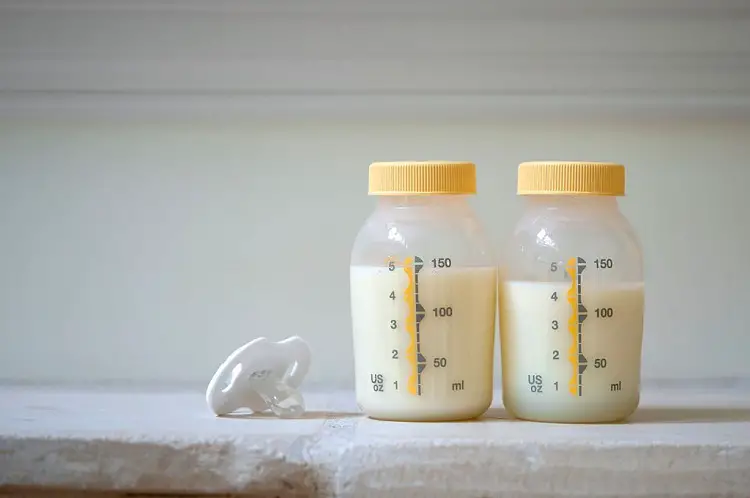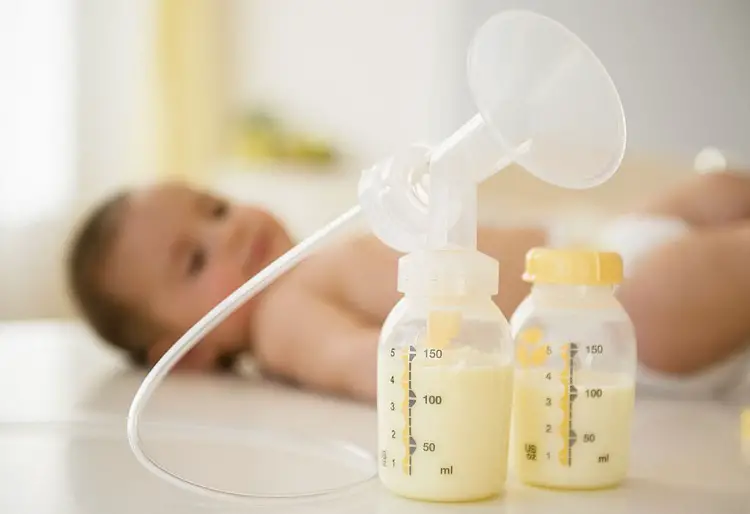The stress mothers go through is proof that motherhood is not a walk in the park. The body undergoes the long months of pregnancy to the different changes during breastfeeding.
Many women who do not have the luxury of nursing their babies opt for more convenient options like pumping breast milk into feeding bottles and storing them up for when their babies need it in their absence.
But there are situations where the baby won’t drink pumped milk no matter how hard you try.
Figuring Out The Cause
Mothers who do not produce so much milk can attest that pumping breast milk to fill a single feeding bottle isn’t easy. It takes long and painful hours of consistently massaging the breast to squeeze out the milk.
But this stress can only be understood by the mother. On the other hand, the baby is free to enjoy this pumped milk; however, you could also go through the stress of pumping two bottles full, and your baby won’t drink pumped milk.
It is not always their fault, as situations will make your baby reject the same milk he enjoys while sucking just because it has been pumped and stored into a bottle.
Reasons Why Your Baby Won’t Drink Pumped Milk
Unsterilized or dirty bottles
Being the adults that we are, sometimes we forget that babies are humans too, and they’re equally as sensitive, if not more, to their environment as we are.
The breasts are one of the world’s wonders if you look at them closely. Not just for its appearance and purpose but for how it can sterilize itself.
The breasts have a gland in the areolas called the Montgomery glands, which are usually more active in breastfeeding women.
The Montgomery glands secret an oily substance around the nipples and areolas, which helps clean the nipples and reduce the bacteria – making cleaning the breast before breastfeeding needless.
Excessive Lipase
High lipase could be a problem for you and your baby. Lipase is an enzyme that speeds up the breakdown of fat in the body. For an adult, excessive lipase is an indication that the person is suffering from pancreatitis, a condition of an inflamed pancreas.
Lipase is needed to aid digestion and absorption of fat in the bloodstream. However, high lipase in breast milk could alter the flavor of the milk.
Lipase is a quick-acting catalyst like every other enzyme that breaks down fat quickly, especially in cool temperatures. Milk stored in a refrigerator with high lipase will undergo this breakdown and be left to taste and smell differently.
A Chemical Oxidation
The word “chemical oxidation” may sound scary, but it is simpler than it sounds. Chemical oxidation occurs when the mother consumes much-polyunsaturated fats, copper, and iron.
This can be detected when the breast milk tastes rancid and sour rather than the usual soapy smell of breast milk. Tasting all these in your milk, surely, your baby won’t drink pumped milk.
A Picky Baby
Another logical reason why your baby won’t drink pumped milk is for the sake of preference.
If we adults can be picky with food, babies have shown times without number that they can equally be picky with a few things. Your baby may dislike munching on the rubber nipple of a feeding bottle.
Read: Best Formula For Picky Breastfed Babies
How to Encourage Your Baby to Drink Pumped Milk

Considering the different reasons why your baby won’t drink pumped milk, the next line of action is to think of how best to resolve the issue.
Some mothers who can afford to abandon the whole routine of pumping and storing milk for their babies can overlook the situation and still feed their babies well. But not all mothers are privileged to nurse their babies as they should.
Either because they have resumed work, health challenges, or something related. Such mothers will need to make their babies drink the milk they pump. Here are a few things to encourage your baby to drink pumped milk.
1. Properly clean and sterilize the feeding bottles
Since one common reason why your baby won’t drink pumped milk is because of dirty bottles, you may want to pay more attention to how you clean the feeding bottles.
Here are some quick steps to clean the feeding bottles and pump kit.
- Use hot water to wash the bottles before and after pumping the milk. When it empties, soak the kit in hot water and let it kill the bacteria that must have started forming.
- Rinse with clean cold water and air dry in a sterile space, preferably an enclosed space small enough to contain the bottles and pump kit yet spacious enough to accommodate the air that will dry the materials.
- It is necessary to always soak the bottles in hot water for babies born premature or in intensive care and below 4 months of age.
- In both cases, do not use soap to wash the item and not to introduce harmful chemicals to your baby’s food.
2. Avoid certain foods
Avoid foods with high polyunsaturated fats like whole flour, seeds, oils, and nuts. Steadily consuming these foods can cause your milk to go bad.
3. Scald your milk before you feed
If you’re dealing with high lipase, scald your breast milk before feeding it to your baby to eliminate the soapy smell and taste.
For those who may not be familiar with how scalding is done, here is how.
- Heat the milk at 180°F. To know when it is done, observe the tiny bubbles around the edges of the pan.
- Bring down the heated milk and leave it to cool before storing or feeding your baby.
4. Mix frozen milk with fresh milk
If your milk is high in lipase, keep it frozen and get your fresh milk to dilute the soapy taste. This strategy is the most likely to be a success.
Here is how to mix “lipase milk” with fresh milk
- Begin with a bottle of mostly fresh milk, and add a splash of lipase milk.
- If your baby will take it, add a little more the next time until you reach half lipase, half fresh milk.
Feeding your baby frozen milk can be a daunting task. You may use this method repeatedly to use your frozen milk. Discard any leftover milk that your baby couldn’t consume.
5. Try frozen milk from a different time
Don’t give up after a few bottles if you have a big freezer stash of breast milk that you pumped over months.
Sometimes, fresher milk may not be as affected, and your baby will take it. There are times when the amount of lipase in the milk you pumped might have worsened over time, causing the older milk to be fine.
Also, sometimes how quickly you freeze the milk may make a difference. The milk you froze right away versus sitting in the fridge for some days might not be as affected.
6. Offer your baby pumped milk when he is really hungry
When we are hungry and have no other option, we settle for something we don’t particularly like.
If your baby is resistant to lipase milk, try feeding it to them first thing in the morning when they are the most hungry (mixed or not) and see if it makes any difference.
If he won’t take it after a few minutes, then it’s not going to work, and you can feed a fresh bottle of breast milk or formula instead.
7. Try different temperatures
This is another easy method to try out. Sometimes a warmer bottle can help fix the situation.
You don’t want your baby to get too hot, but if you’re serving lukewarm or room-temperature milk, try warming it up a bit.
This is less likely to work and more something you can try out of desperation.
These recommended strategies are all valid and worth trying out. However, you should update a feeding/pumping plan to meet the baby’s needs while accommodating the parent’s life.
Consulting with a local Lactation Consultant to support you in making a plan is highly recommended. Do not forget your sleep schedule as an essential part of your plan. Make sure your support team at home is part of it. It may be challenging to manage, but you can do this.
Read Also: How to Use Medela Breast Pump (10 Easy Steps)
Conclusion
If your baby won’t drink pumped milk, observe him closely to know the reason and act accordingly.
Even if none of the above strategies work, don’t give up. Babies change so fast! Your baby might refuse lipase milk with extreme prejudice in the first month and take it in the second. You never know.
For every possible cause of your baby refusing to drink pumped milk, there is a solution that will help you conveniently breastfeed your baby.
